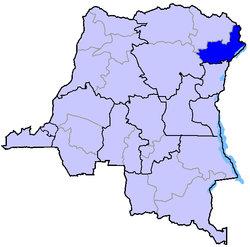Effacer le tableau
Effacer le tableau ("erasing the board" or "cleaning the slate") was the operational name given to the systematic extermination of the Bambuti pygmies by rebel forces in the Democratic Republic of the Congo (DRC).[3]
| Effacer le tableau | |
|---|---|
| Part of Second Congo War and Violence against pygmies | |
_-_Nord-Kivu.svg.png.webp) Map of North Kivu within the DRC. | |
 Map of Ituri Rainforest | |
| Location | North Kivu and Ituri Rainforest, Democratic Republic of the Congo |
| Date | October 2002 to January 2003 |
Attack type | Genocidal massacre, Ethnic cleansing, cannibalism, war rape[1] |
| Deaths | 60,000[1][2] to 70,000[2] (40% of the Eastern Congo's Pygmy population killed)[N 1] |
| Victims | Bambuti pygmies |
| Perpetrators | Movement for the Liberation of Congo (Jean-Pierre Bemba) |
| Motive | Territorial conquest of the North Kivu province of the DRC |
History
The extermination was carried out by soldiers from the Movement for the Liberation of Congo (MLC), who became known to locals as les effaceurs ("the erasers"), and troops from the Rally for Congolese Democracy (RCD-N).[4]
The primary objective of Effacer le tableau was the territorial conquest of the North Kivu province of the DRC and ethnic cleansing of Pygmies from the Congo's eastern region whose population numbered 90,000 by 2004.[1] The Bambuti were targeted specifically as the rebels considered them "subhuman", and it was believed by the rebels that the flesh of the Bambuti held "magical powers". There were also reports of cannibalism being widespread.[5] It is estimated 60,000 to 70,000[2] Pygmy were killed in the campaign.
In March 2016 the International Criminal Court found Jean-Pierre Bemba guilty of human rights violations in the Central African Republic. Bemba was the vice president of the DRC, and leader of the MLC during the year long extermination campaign[6] but was fully acquitted by the ICC's appeal court in June 2018.
References
- Penketh, Anne (2004-07-07). "Extermination of the pygmies". The Independent. Archived from the original on 2018-12-21. Retrieved 2018-12-21.
- "Between October 2002 and January 2003, two the rebel groups, the MLC and RCD-N in the East of the Congo launched a premeditated, systematic genocide against the local tribes and Pygmies nicknamed operation "Effacer le Tableau" ("erase the board"). During their offensive against the civilian population of the Ituri region, the rebel groups left more than 60,000 dead and over 100,000 displaced. The rebels even engaged in slavery and cannibalism. Human Rights Reports state that this was due to the fact that rebel groups, often far away from their bases of supply and desperate for food, enslaved the Pygmies on captured farms to grow provisions for their militias or when times get really tough simply slaughter them like animals and devour their flesh which some believe gives them magical powers. 11. Fatality Level of Dispute (military and civilian fatalities): 70,000 estimated" see: Raja Seshadri (7 November 2005). "Pygmies in the Congo Basin and Conflict". Case Study 163. The Inventory of Conflict & Environment, American University. Archived from the original on 4 March 2016. Retrieved 21 July 2012.
- Penketh 2004.
- Deibert 2013, p. 98.
- Gilbert 2016, p. 43.
- Lattimer 2016.
Notes
- Eastern Pygmy population was reduced to 90,000 after a campaign that killed 60,000[2] implying a 40% decline
Bibliography
- Gilbert, Jérémie (2016). Nomadic Peoples and Human Rights (1st ed.). Routledge. p. 43. ISBN 978-1138666498.CS1 maint: ref=harv (link)
- Lattimer, Mark (21 March 2016). "Bemba guilty verdict upholds doctrine of command responsibility". Minority Rights Group International. Retrieved 6 August 2017.CS1 maint: ref=harv (link)
- Penketh, Anne (6 July 2004). "Extermination of the pygmies". The Independent. Retrieved 2 August 2017.CS1 maint: ref=harv (link)
- Deibert, Michael (12 September 2013). The Democratic Republic of Congo: Between Hope and Despair. Zed Books Ltd. ISBN 978-1-78032-348-0.CS1 maint: ref=harv (link)